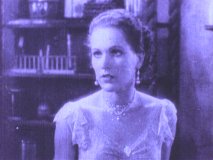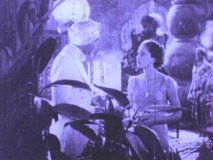Rose Hobart (Joseph Cornell, 1936)
 In his jaunty short film, Rose Hobart, sometimes-filmmaker Joseph Cornell recycles a
disposable tchotchke from Hollywood’s halcyon days and forms an unusual
masterpiece. Consisting entirely of found, but significantly re-edited, footage
from an obscure, and seemingly clichéd, 1931 Hollywood jungle adventure
entitled East of Borneo, starring an actress named Rose Hobart, Rose
Hobart gives its viewers an opportunity to reassess the complexity of the
images they see when they watch even the simplest of mainstream films.
Cornell’s reformatting of Borneo essentially
excises from that movie most of the elements that aren’t Ms. Hobart. Nearly
every shot contains her, which results in an obsessive reprioritization that
serves to remind the audience of the interplay of voyeurism and exhibitionism
that makes the actors that we see on the screen so exciting to the viewer. With
this new, Rose-centric context, every other element that exists in the movie is
there to flesh out our heroine’s inner life. As she’s put through the
motions of Cornell’s non-chronological editing, she is alternatively a sex
object, an identifiable human being, a totem signifying dread, and a surrogate
mother to a stray monkey.
In his jaunty short film, Rose Hobart, sometimes-filmmaker Joseph Cornell recycles a
disposable tchotchke from Hollywood’s halcyon days and forms an unusual
masterpiece. Consisting entirely of found, but significantly re-edited, footage
from an obscure, and seemingly clichéd, 1931 Hollywood jungle adventure
entitled East of Borneo, starring an actress named Rose Hobart, Rose
Hobart gives its viewers an opportunity to reassess the complexity of the
images they see when they watch even the simplest of mainstream films.
Cornell’s reformatting of Borneo essentially
excises from that movie most of the elements that aren’t Ms. Hobart. Nearly
every shot contains her, which results in an obsessive reprioritization that
serves to remind the audience of the interplay of voyeurism and exhibitionism
that makes the actors that we see on the screen so exciting to the viewer. With
this new, Rose-centric context, every other element that exists in the movie is
there to flesh out our heroine’s inner life. As she’s put through the
motions of Cornell’s non-chronological editing, she is alternatively a sex
object, an identifiable human being, a totem signifying dread, and a surrogate
mother to a stray monkey.
 Cornell’s movie reprocesses Borneo’s most evocative images by slowing down the frame, allowing
them to sink in. Exploding volcanoes, a water ripple, a
seashell sinking into a cup, and a solar eclipse are just a few of the visuals
taken from the film and extended here to the point where they become metaphoric
mood markers. Just because these fleeting symbols do not register to this extent
in their intended context, doesn’t mean that they don’t have a more
subliminal effect on the viewer who has plot to distract them from what they are
seeing. Furthermore, in Rose Hobart,
the viewer is freer to absorb the intense exoticism that served as background
dressing in Borneo. The raging
natives, beastly alligators and impenetrable jungle are all amplified and
sexualized by Rose’s bouncy, yet
mysterious, samba soundtrack and a purple tint (Cornell achieved it during the
film’s public screenings by projecting the film through a piece of purple
glass), which gives the movie a decidedly dreamy atmosphere.
Cornell’s movie reprocesses Borneo’s most evocative images by slowing down the frame, allowing
them to sink in. Exploding volcanoes, a water ripple, a
seashell sinking into a cup, and a solar eclipse are just a few of the visuals
taken from the film and extended here to the point where they become metaphoric
mood markers. Just because these fleeting symbols do not register to this extent
in their intended context, doesn’t mean that they don’t have a more
subliminal effect on the viewer who has plot to distract them from what they are
seeing. Furthermore, in Rose Hobart,
the viewer is freer to absorb the intense exoticism that served as background
dressing in Borneo. The raging
natives, beastly alligators and impenetrable jungle are all amplified and
sexualized by Rose’s bouncy, yet
mysterious, samba soundtrack and a purple tint (Cornell achieved it during the
film’s public screenings by projecting the film through a piece of purple
glass), which gives the movie a decidedly dreamy atmosphere.
 Because of Rose
Hobaart’s non-chronological
editing, there are new intrigues in each shot / counter-shot edit. This serves
as a reminder of the foundations of cinematic grammar and a simultaneous
opportunity to take pleasure in the joy that is the cinematic language. From one
shot to the next, her outfits, conversational partners and location changes.
These juxtapositions prompt constant reassessment of her in a way that would
occur much more gradually if watching the film in the order in which it was
intended to be seen. The gestures of the actress, already exaggerated by the
camera’s focus on her and the way that she is lit, are further augmented by an
editing scheme that isolates them in the shot sequencing. Borneo’s
over-reliance on the eye-line - always a cornerstone of establishing editorial
continuity - allows Cornell to link shots that weren’t originally intended to
be placed alongside one another in the purposely disruptive editing scheme.
Because of Rose
Hobaart’s non-chronological
editing, there are new intrigues in each shot / counter-shot edit. This serves
as a reminder of the foundations of cinematic grammar and a simultaneous
opportunity to take pleasure in the joy that is the cinematic language. From one
shot to the next, her outfits, conversational partners and location changes.
These juxtapositions prompt constant reassessment of her in a way that would
occur much more gradually if watching the film in the order in which it was
intended to be seen. The gestures of the actress, already exaggerated by the
camera’s focus on her and the way that she is lit, are further augmented by an
editing scheme that isolates them in the shot sequencing. Borneo’s
over-reliance on the eye-line - always a cornerstone of establishing editorial
continuity - allows Cornell to link shots that weren’t originally intended to
be placed alongside one another in the purposely disruptive editing scheme.
 One could easily argue that any film
contains these elements for an audience member willing to dissect it thoroughly
enough, but Cornell is actively trying to make us aware of these things and
excite us by reminding us that they are always there for those who look. This
exercise reminds us how intensely encoded narrative cinema is and reasserts how
the critical mind should watch films. The narrative that Borneo
once had is purposely impossible to ascertain in Rose Hobart, except by applying dream logic, which seems to suggest
there’s a hidden life, which exists through pictures, lurking in even the most
superficial and trite motion pictures. Even though the technique in a narrative
feature is there primarily to serve the film’s plot, the determined focus on
plot gets in the way of our ability to actively comprehend the cinematically
encoded information that we’re seeing. Rose
Hobart asks us to reawaken the dreamer that watches any given film alongside
us. Almost ironically, that makes it the perfect movie to fall asleep to.
One could easily argue that any film
contains these elements for an audience member willing to dissect it thoroughly
enough, but Cornell is actively trying to make us aware of these things and
excite us by reminding us that they are always there for those who look. This
exercise reminds us how intensely encoded narrative cinema is and reasserts how
the critical mind should watch films. The narrative that Borneo
once had is purposely impossible to ascertain in Rose Hobart, except by applying dream logic, which seems to suggest
there’s a hidden life, which exists through pictures, lurking in even the most
superficial and trite motion pictures. Even though the technique in a narrative
feature is there primarily to serve the film’s plot, the determined focus on
plot gets in the way of our ability to actively comprehend the cinematically
encoded information that we’re seeing. Rose
Hobart asks us to reawaken the dreamer that watches any given film alongside
us. Almost ironically, that makes it the perfect movie to fall asleep to.
85
05-03-04
Jeremy Heilman